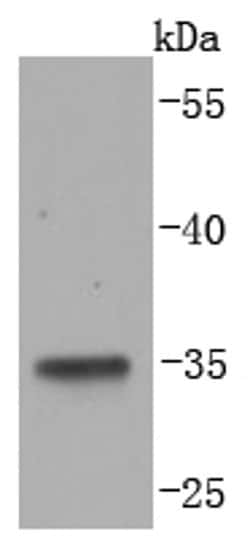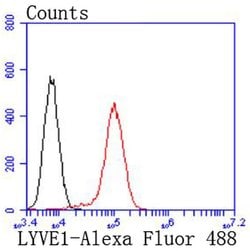Learn More
Invitrogen™ LYVE1 Recombinant Rabbit Monoclonal Antibody (JF0979)
Rabbit Recombinant Monoclonal Antibody
Supplier: Invitrogen™ MA532512
Description
Recombinant rabbit monoclonal antibodies are produced using in vitro expression systems. The expression systems are developed by cloning in the specific antibody DNA sequences from immunoreactive rabbits. Then, individual clones are screened to select the best candidates for production. The advantages of using recombinant rabbit monoclonal antibodies include: better specificity and sensitivity, lot-to-lot consistency, animal origin-free formulations, and broader immunoreactivity to diverse targets due to larger rabbit immune repertoire.
LYVE1 has been identified as a major receptor for HA (extracellular matrix glycosaminoglycan hyaluronan) on the lymph vessel wall. The deduced amino acid sequence of LYVE1 predicts a 322-residue type I integral membrane polypeptide 41% similar to the CD44 HA receptor with a 212-residue extracellular domain containing a single Link module, the prototypic HA binding domain of the Link protein superfamily. Like CD44, the LYVE1 molecule binds both soluble and immobilized HA. However, unlike CD44, the LYVE1 molecule colocalizes with HA on the luminal face of the lymph vessel wall and is completely absent from blood vessels. Hence, LYVE1 is the first lymph-specific HA receptor to be characterized and is a uniquely powerful marker for lymph vessels themselves. LYVE1 is a type I integral membrane glycoprotein. LYVE-1 is expressed primarily on lymphatic vessel endothelium and is likely to be involved in regulating the traffic of leucocytes and tumor cells to lymph nodes. The lymphatic vasculature forms a second circulatory system that drains extracellular fluid from the tissues and provides an exclusive environment in which immune cells can encounter and respond to foreign antigen. A number of molecules have been identified as markers for lymphatic endothelium which include LYVE1, PALE, VEGFR3, and podoplanin. Diseases associated with LYVE1 dysfunction includes Complete Androgen Insensitivity Syndrome.
Specifications
| LYVE1 | |
| Recombinant Monoclonal | |
| 1 mg/mL | |
| TBS with 0.05% BSA, 40% Glycerol and 0.05% sodium azide; pH 7.4 | |
| Q9Y5Y7 | |
| Lyve1 | |
| Synthetic peptide within Human LYVE1 aa 36-72. | |
| 100 μL | |
| Primary | |
| Human, Mouse, Rat | |
| Antibody | |
| IgG |
| Flow Cytometry, Western Blot, Western Blot, Immunohistochemistry, Western Blot | |
| JF0979 | |
| Unconjugated | |
| Lyve1 | |
| 1200012G08Rik; cell surface retention sequence binding protein-1; cell surface retention sequence-binding protein 1; CRSBP1; CRSBP-1; extra cellular link domain-containing 1; extracellular link domain containing 1; extracellular link domain-containing 1; extracellular link domain-containing protein 1; HAR; hyaluronic acid receptor; lymphatic endothelial hyaluronan receptor LYVE-1; lymphatic vessel endothelial HA receptor-1; lymphatic vessel endothelial HA recptor-1; lymphatic vessel endothelial hyaluronan receptor 1; lymphatic vessel endothelial hyaluronic acid receptor 1; LYVE1; LYVE-1; sLyve 1; sLyve1; soluble LYVE 1; soluble LYVE1; UNQ230/PRO263; XLKD1 | |
| Rabbit | |
| Protein A | |
| RUO | |
| 10894 | |
| Store at 4°C short term. For long term storage, store at -20°C, avoiding freeze/thaw cycles. | |
| Liquid |
Your input is important to us. Please complete this form to provide feedback related to the content on this product.

